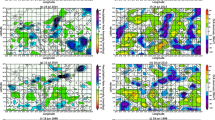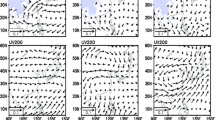Abstract
This study aims to detect the primary precursors and impact mechanisms for January surface temperature anomaly (JSTA) events in China against the background of global warming, by comparing the causes of two extreme JSTA events occurring in 2008 and 2011 with the common mechanisms inferred from all typical episodes during 1979–2008. The results show that these two extreme events exhibit atmospheric circulation patterns in the mid–high latitudes of Eurasia, with a positive anomaly center over the Ural Mountains and a negative one to the south of Lake Baikal (UMLB), which is a pattern quite similar to that for all the typical events. However, the Eurasian teleconnection patterns in the 2011 event, which are accompanied by a negative phase of the North Atlantic Oscillation, are different to those of the typical events and the 2008 event. We further find that a common anomalous signal appearing in early summer over the tropical Indian Ocean may be responsible for the following late-winter Eurasian teleconnections and the associated JSTA events in China. We show that sea surface temperature anomalies (SSTAs) in the preceding summer over the western Indian Ocean (WIO) are intimately related to the UMLB-like circulation pattern in the following January. Positive WIOSSTAs in early summer tend to induce strong UMLB-like circulation anomalies in January, which may result in anomalously or extremely cold events in China, which can also be successfully reproduced in model experiments. Our results suggest that the WIOSSTAs may be a useful precursor for predicting JSTA events in China.
Access this article
We’re sorry, something doesn't seem to be working properly.
Please try refreshing the page. If that doesn't work, please contact support so we can address the problem.
Similar content being viewed by others
References
Black, R. X., 2001: Stratospheric forcing of surface climate in the Arctic oscillation. J. Climate, 15, 268–277, doi: 10.1175/1520-0442(2002)015<0268:SFOSCI>2.0.CO;2.
Chen, H. S., H. D. Ma, X. Li, et al., 2015: Solar influences on spatial patterns of Eurasian winter temperature and atmospheric general circulation anomalies. J. Geophys. Res. Atmos., 120, 8642–8657, doi: 10.1002/2015JD023415.
Chen, W., and R. H. Huang, 2005: The three-dimensional propagation of quasi-stationary planetary waves in the Northern Hemisphere winter and its interannual variations. Chinese J. Atmos. Sci., 29, 137–146, doi: 10.3878/j.issn.1006-9895.2005.01.16. (in Chinese)
Chen, W., L. Gu, K. Wei, et al., 2008: Studies of the dynamic processes of East Asian monsoon system and the quasi-stationary planetary wave activities. Chinese J. Atmos. Sci., 32, 950–966, doi: 10.3878/j.issn.1006-9895.2008.04.20. (in Chinese)
Collins, W. D., P. J. Rasch, B. A. Boville, et al., 2004: Description of the NCAR Community Atmosphere Model (CAM3.0). NCAR Technical Note NCAR /TN-464+STR, National Center for Atmospheric Research. Boulder, Colorado, 214 pp, doi:10.5065/D63N21CH
Ding, Y. H., Z. Y. Wang, Y. F. Song, et al., 2008: The unprecedented freezing disaster in January 2008 in southern China and its possible association with the global warming. Acta Meteor. Sinica, 22, 538–558.
Fu, J. J., S. L. Li, and Y. M. Wang, 2008: Influence of prior thermal state of global oceans on the formation of the disastrous snow storm in January 2008. Climatic Environ. Res., 13, 478–490. (in Chinese)
Gong, D. Y., and S. W. Wang, 2003: Influence of Arctic oscillation on winter climate over China. J. Geogr. Sci., 13, 208–216, doi: 10.1007/BF02837460.
Gong, D. Y., Y. Q. Gao, D. Guo, et al., 2014: Interannual linkage between Arctic/North Atlantic oscillation and tropical Indian ocean precipitation during boreal winter. Climate Dyn., 42, 1007–1027, doi: 10.1007/s00382-013-1681-4.
Guo, Q. Y., 1994: Relationship between the variations of East Asian winter monsoon and temperature anomalies in China. Quart. J. Appl. Meteor., 5, 218–225. (in Chinese)
Hong, C.-C., H.-H. Hsu, H.-H. Chia, et al., 2008: Decadal relationship between the North Atlantic oscillation and cold surge frequency in Taiwan. Geophys. Res. Lett., 35, L24707, doi: 10.1029/2008GL034766.
Hoskins, B. J., and D. J. Karoly, 1981: The steady linear response of a spherical atmosphere to thermal and orographic forcing. J. Atmos. Sci., 38, 1179–1196, doi: 10.1175/1520-0469(1981)038<1179:TSLROA>2.0.CO;2.
Jeong, J.-H., and C.-H. Ho, 2005: Changes in occurrence of cold surges over East Asia in association with Arctic Oscillation. Geophys. Res. Lett., 32, L14704, doi: 10.1029/2005GL023024.
Kalnay, E., M. Kanamitsu, R. Kistler, et al., 1996: The NCEP/NCAR 40-year reanalysis project. Bull. Amer. Meteor. Soc., 77, 437–470, doi: 10.1175/1520-0477(1996)077<0437:TNYRP>2.0.CO;2.
Li, C., and Q. Y. Zhang, 2015: An observed connection between wintertime temperature anomalies over Northwest China and weather regime transitions in North Atlantic. J. Meteor. Res., 29, 201–213, doi: 10.1007/s13351-015-4066-2.
Li, C. Y., 1989: El Niño and warm winter over eastern China. Chinese Sci. Bull., 34, 283–286. (in Chinese)
Li, C. Y., and W. Gu, 2010: An analyzing study of the anomalous activity of blocking high over the Ural mountains in January 2008. Chinese J. Atmos. Sci., 34, 865–874, doi: 10.3878/j.issn.1006-9895.2010.05.02. (in Chinese)
Li, C. Y., H. Yang, and W. Gu, 2008: Cause of severe weather with cold air, freezing rain and snow over south China in January 2008. Climatic Environ. Res., 23, 113–122. (in Chinese)
Li, F., H. J. Wang, and Y. Q. Gao, 2017: Stratospheric precursor of non-uniform variation in early spring surface temperature over Eurasia. J. Meteor. Res., 31, 389–396, doi: 10.1007/s13351-017-6055-0.
Li, S. L., and G. T. Bates, 2007: Influence of the Atlantic multidecadal oscillation on the winter climate of East China. Adv. Atmos. Sci., 24, 126–135, doi: 10.1007/s00376-007-0126-6.
Lu, R. Y., Y. Li, and B. W. Dong, 2007: Arctic oscillation and Antarctic oscillation in internal atmospheric variability with an ensemble AGCM simulation. Adv. Atmos. Sci., 24, 152–162, doi: 10.1007/s00376-007-0152-4.
Park, T.-W., C.-H. Ho, and S. Yang, 2011: Relationship between the Arctic oscillation and cold surges over East Asia. J. Climate, 24, 68–83, doi: 10.1175/2010JCLI3529.1.
Perlwitz, J., and H. F. Graf, 2001: Troposphere–stratosphere dynamic coupling under strong and weak polar vortex conditions. Geophys. Res. Lett., 28, 271–274, doi: 10.1029/2000GL012405.
Song, J., and C. Y. Li, 2009: The linkages between the Antarctic Oscillation and the Northern Hemisphere circulation anomalies. Chinese J. Atmos. Sci., 33, 847–858, doi: 10.3878/j.issn.1006-9895.2009.04.17. (in Chinese)
Tan, G. R., W. J. Zhu, G. Zeng, et al., 2009: Possible influence of stratospheric circulation on January surface air temperature over China. Proceedings of SPIE 7456, Atmospheric and Environmental Remote Sensing Data Processing and Utilization V: Readiness for GEOSS III. San Diego, CA, SPIE, 7456, 745612, doi: 10.1117/12.825852.
Tan, G. R., H. S. Chen, Z. B. Sun, et al., 2010: Linkage of the cold event in January 2008 over China to the North Atlantic oscillation and stratospheric circulation anomalies. Chinese J. Atmos. Sci., 34, 175–183, doi: 10.3878/j.issn.1006-9895.2010.01.16. (in Chinese)
Tan, G.-R., F.-F. Jin, H.-L. Ren, et al., 2014: The role of eddy feedback in the excitation of the NAO. Meteorol. Appl., 21, 768–776, doi: 10.1002/met.1415.
Tan, G.-R., H.-L. Ren, and H. S. Chen, 2015: Quantifying synoptic eddy feedback onto the low-frequency flow associated with anomalous temperature events in January over China. Int. J. Climatol., 35, 1976–1983, doi: 10.1002/joc.4135.
Wang, D. H., C. J. Liu, Y. Liu, et al., 2008: A preliminary analysis of features and causes of the snow storm event over the southern China in January 2008. Acta Meteor. Sinica, 66, 405–422. (in Chinese)
Wang, L., and W. Chen, 2010: Downward arctic oscillation signal associated with moderate weak stratospheric polar vortex and the cold December 2009. Geophys. Res. Lett., 37, L09707, doi: 10.1029/2010GL042659.
Wang, L., W. Chen, and R. H. Huang, 2007: Changes in the variability of North Pacific Oscillation around 1975/1976 and its relationship with East Asian winter climate. J. Geophys. Res., 112, D11110, doi: 10.1029/2006JD008054.
Wang, L., W. Chen, W. Zhou, et al., 2009: Interannual variations of East Asian trough axis at 500 hPa and its association with the East Asian winter monsoon pathway. J. Climate, 22, 600–614, doi: 10.1175/2008JCLI2295.1.
Wang, Y. F., Y. Li, P. Y. Li, et al., 2008: The large scale circulation of the snow disaster in South China in the beginning of 2008. Acta Meteor. Sinica, 66, 826–835. (in Chinese)
Warren II, R. J., and M. A. Bradford, 2010: Seasonal climate trends, the North Atlantic oscillation, and salamander abundance in the southern Appalachian mountain region. J. Appl. Meteor., 49, 1597–1603, doi: 10.1175/2010JAMC2511.1.
Wen, M., S. Yang, A. Kumar, et al., 2009: An analysis of the large-scale climate anomalies associated with the snowstorms affecting China in January 2008. Mon. Wea. Rev., 137, 1111–1131, doi: 10.1175/2008MWR2638.1.
Wu, B. Y., and J. Wang, 2002: Possible impacts of winter Arctic oscillation on Siberian high, the East Asian winter monsoon, and sea-ice extent. Adv. Atmos. Sci., 19, 297–320, doi: 10.1007/s00376-002-0024-x.
Xie, Z. W., and C. Bueh, 2017: Blocking features for two types of cold events in East Asia. J. Meteor. Res., 31, 309–320, doi: 10.1007/s13351-017-6076-8.
Zhang, M., Y. C. Qi, and X. M. Hu, 2014: Impact of East Asian winter monsoon on the Pacific storm track. Meteor. Appl., 21, 873–878, doi: 10.1002/met.1423.
Zhou, X. Y., W. J. Zhu, and C. Gu, 2015: Possible influence of the variation of the northern Atlantic storm track on the activity of cold waves in China during winter. Chinese J. Atmos. Sci., 39, 978–990, doi: 10.3878/j.issn.1006-9895.1501.14259. (in Chinese)
Zuo, Z. Y., S. Yang, R. H. Zhang, et al., 2013: Long-term variations of broad-scale Asian summer monsoon circulation and possible causes. J. Climate, 26, 8947–8961, doi: 10.1175/JCLI-D-12-00691.1.
Zuo, Z. Y., R. H. Zhang, Y. Huang, et al., 2015: Extreme cold and warm events over China in wintertime. Int. J. Climatol., 35, 3568–3581, doi: 10.1002/joc.4229.
Acknowledgments
The authors thank Weitao Deng and Xing Geng for their help in running the model experiments and drawing some charts.
Author information
Authors and Affiliations
Corresponding author
Additional information
Supported by the National Natural Science Foundation of China (41475088), National Science and Technology Support Program of China (2015BAC03B02), China Meteorological Administration Special Public Welfare Research Fund (GYHY201306028 and GYHY201506013), and Project for Development of Key Techniques in Meteorological Forecasting Operation (YBGJXM201705).
Rights and permissions
About this article
Cite this article
Tan, G., Ren, HL., Chen, H. et al. Detecting primary precursors of January surface air temperature anomalies in China. J Meteorol Res 31, 1096–1108 (2017). https://doi.org/10.1007/s13351-017-7013-6
Received:
Accepted:
Published:
Issue Date:
DOI: https://doi.org/10.1007/s13351-017-7013-6




